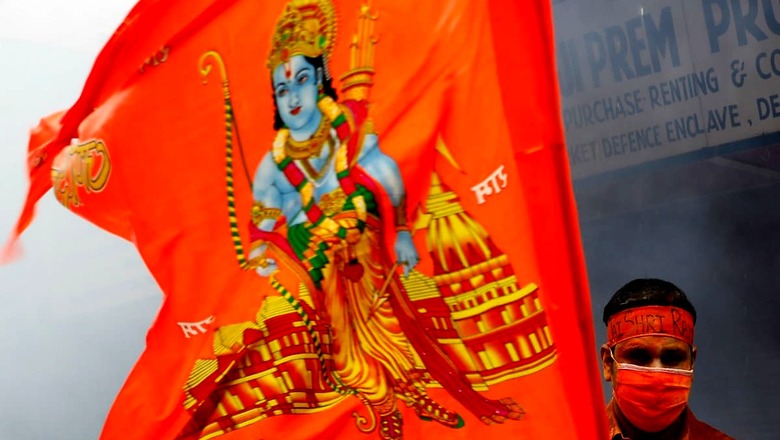
views
Before Prime Minister Narendra Modi attended the ground-breaking ceremony of the Ram Temple at Ayodhya, Hindutva demagogue Sambhajirao Bhide Guruji, a man whom he is said to admire, made a strange demand.
The octogenarian, who leads ‘Shivaprathisthan Hindustan’ and uses the imagery of Chatrapati Shivaji Maharaj for mass mobilisation, sought that the idol of Lord Ram in the shrine must have a moustache.
Bhide, a militant Hindutva leader, demanded that the idols of Lord Ram and Lakshman must sport moustaches in keeping with the age-old martial convention among men from Kshatriya communities. Bhide said he had also spoken about this to Govind Giri Maharaj, a trustee of the Shri Ram Janmabhoomi Teertha Kshetra trust, and added that if the idols did not have a moustache, the shrine would not be of any value to devotees like him.
Bhide’s supporters point to how idols of Lord Ram and Lakshman in temples like the Kalaram Mandir at the pilgrimage centre of Nashik, which is revered as another Kashi, have such moustaches. The depiction of the God sans facial hair was started in films and television serials, they claim, adding that hence, the idols at Ayodhya, which is revered as Ram’s birthplace, must set things right. Incidentally, Bhide has an ample crop of facial hair, with a Walrus-like moustache.
The demand has been dismissed by Mahant Satyendra Das, the chief priest of the Ram Lalla Temple at Ayodhya, who has claimed that those insisting on this were not familiar with the finer aspects of Hinduism. Das claimed that deities Rama, Krishna and Shiva were perpetually aged 16 years, and said there was no precedent for having such idols with moustaches.
This is not for the first time that Bhide, who is among those accused in the violence against Dalits who came to the Bhima-Koregaon war memorial near Pune on January 1, 2018, has made a controversial or bizarre statement. On Monday, Bhide also called on people to attend flag hoisting events on Independence Day regardless of the coronavirus pandemic, lockdown and social distancing norms.
In 2018, Bhide claimed that eating mangoes from his farm led to people conceiving children and begetting sons. This got him into trouble with public health authorities, who initiated action under the Pre-Natal Diagnostic Techniques (Regulation and Prevention of Misuse) Act, 1994 (PCPNDT). In the same year, he declared that Manu, the ancient law maker, was greater than saints.
He also claimed that Dr Babasaheb Ambedkar attended the inauguration of the statue of Manu in Rajasthan. This was debunked as Ambedkar had burnt the Manusmruti in 1927 to protest its codification of caste hegemony. The father of the Indian Constitution passed away in 1956, while this statue in the premises of Rajasthan High Court was inaugurated in 1989.
Like the Ram Temple, which is a project close to the heart of Hindutva activists, Bhide has launched a project to collect donations from people to erect a 144kg sinhasan (throne) of gold for Chatrapati Shivaji Maharaj at his capital of Raigad.
The dharkaris (as members of Shivaprathisthan are called), who have rallied for the cause, are undeterred by the fort being a monument protected by the Archeological Survey of India (ASI), with construction and development being regulated.
Bhide, who shot to fame in 2008 after protesting against the movie ‘Jodha Akbar’ in Sangli, is a man who invokes respect and criticism in equal measure. Hailing from Osmanabad (or Dharashiv as it is called by Hindutva adherents) from a family which was said to have substantial landed properties, he worked as a teacher and was an RSS pracharak before establishing his own outfit decades ago.
The sinewy Bhide, who is said to be around 87 years old, is reputed for performing over 100 suryanamaskars (sun salutations), jors (Hanuman push-ups) and sit ups daily. He does not use footwear, sleeps on the bare floor, shuns tea and coffee, fasts for several days a month, and goes around on a bicycle. His associates vouch for his elephantine memory and discipline and lack of material possessions except few clothes, books and a bicycle.
This emotional personality of its founder is used by the Shivaprathisthan to mobilise the youth for causes like curbing cow slaughter and for promoting a physical culture. Bhide’s supporters claim that the Shivaprathisthan has the support of around three to four lakh active workers in Maharashtra and parts of Karnataka and Madhya Pradesh.
The group has a strong following in parts of Western Maharashtra, especially Sangli, where Bhide is based. This has perhaps led to him being patronised by politicians across the spectrum, including the Bharatiya Janata Party (BJP), Shiv Sena and even local leaders of the Nationalist Congress Party (NCP), including Satara royal family scion and BJP MP Udayanraje Bhosale, who was earlier with the NCP, and is the descendant of Chatrapati Shivaji Maharaj.
Bhide’s detractors accuse him of distorting and weaponising history to target the minorities, especially Muslims, and of deifying Shivaji Maharaj, which underplays the achievements of the 17th century warrior-king.
They accuse Bhide, a Brahmin, of inciting the Bahujan (non-Brahmin) youth by using Shivaji Maharaj’s imagery. This, they state is done through events like an annual trek for youth between forts and “Dharmavir Balidan Maas” in memory of Chatrapati Sambhaji Maharaj who was tortured and killed by Mughal king Aurangzeb. Shivaprathisthan activists have clashed with workers from the anti-Brahmin Sambhaji Brigade, and Dalit groups in the past.
But, regardless of the extreme reactions that his name invokes, fringe Hindutva groups like Shivaprathisthan pose a likely challenge for the Shiv Sena-NCP-Congress Maha Vikas Aghadi (MVA) government in Maharashtra. The Shiv Sena’s alliance with “secular” parties like the Congress and NCP, has forced it to walk the tightrope on the agenda of Hindutva.
In case of such organisations being mobilised by the Sangh Parivar to stir the pot on the issue of Hindutva, the Shiv Sena may be caught in a bind.




















Comments
0 comment